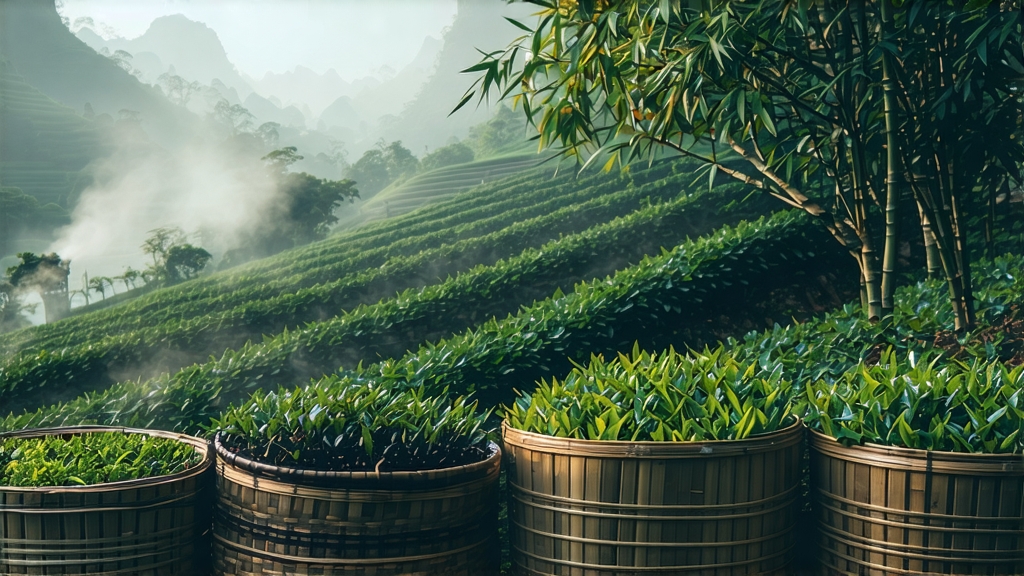
Tucked away in the humid, karst-veined mountains of southern China’s Guangxi Zhuang Autonomous Region, Liu Bao tea has spent four centuries quietly perfecting the art of transformation. While Pu-erh has become the global shorthand for “dark tea,” Liu Bao is the older, subtler sibling—fermented, pressed, and then left to breathe inside woven bamboo baskets whose pores still carry the scent of camphor forests. To drink it is to taste a cool monsoon night in Wuzhou City, to feel the slow heartbeat of a leaf that was once Ming-dynasty currency along the Tea-Horse Road.
History: From Military Ration to Maritime Currency
The name Liu Bao literally means “six forts,” a reference to the six defensive stockades that protected the small mountain township of Cangwu County during the Qing era. By the late 1600s the tea grown there was already being compressed into 40-kilogram baskets, loaded onto bamboo rafts, and floated down the Liu-jiang River to the Pearl Delta, where it was transferred to tall ships bound for Hong Kong, Vietnam, Malaysia, and finally the tin mines of Kuala Lumpur. Colonial physicians noticed that coolies who drank the dark liquor suffered less from dysentery and malaria; mine owners began paying part of wages in tea bricks, and Liu Bao became a clandestine currency more stable than silver. In 1886 the British consul in Guangzhou listed “Liu-pu” among the top three medicinal exports of the province, alongside rhubarb and star anise. When the Malayan Emergency disrupted supply in the 1950s, prices on the Singapore commodity exchange briefly surpassed those of first-flush Darjeeling.
Micro-terroirs Within One County
Purists recognize three micro-zones inside the original six-fort radius. The highest, at 600–800 m, is Gua Jiang Ling, where morning fog lingers until noon; leaves grown here carry a natural orchid note and a higher ratio of golden buds. Middle elevation (300–500 m) is known as He Dong Valley, whose red lateritic soil imparts a sweet, jujube-like thickness. The lowest belt, below 300 m, yields broader leaves with a pronounced betel-nut bitterness prized by Malaysian Teochew merchants who age the tea in open-air godowns where the average humidity hovers at 85 %. Modern producers sometimes blend the three, but single-garden Liu Bao is now experiencing a renaissance among Chinese collectors who compare it to Burgundy’s terroir-driven crus.
Craft: The Invisible Hourglass of Microbes
Unlike Pu-erh, which can be either raw or cooked, Liu Bao is always “cooked” first—an obligatory 45-day wet-pile fermentation invented centuries before its Yunnan counterpart. Fresh leaves are withered 4–6 hours on bamboo trays, then wok-killed at 160 °C for exactly three minutes to lock in a faint grassy note. Rolling is done by foot inside a 1.2-meter cedar trough; the pressure must be firm enough to rupture 60 % of cell walls without breaking the veins, a metric still judged by the master’s bare sole. The pile is then built: 400 kg of damp leaf heaped into a rectangular mound, covered with jute sacks and left to heat spontaneously to 55 °C. Every seven days the pile is turned, sprayed with mountain spring water drawn from 30 m wells, and re-covered. During this phase a microbial consortia dominated by Aspergillus niger, Blastobotrys adeninivorans, and a local yeast dubbed Liu-baoensis MK-7 perform a slow alchemy, converting catechins into theaflavins and producing a unique metabolite, 2-acetyl-1-pyrroline, the same compound that gives basmati rice its popcorn aroma. After six weeks the pile is spread out to cool, then steamed for 90 seconds and pressed into the traditional bamboo “big baskets” (da lou) lined with untreated camphor leaves. The camphor acts as a natural insect repellent and donates a cooling, medicinal edge that becomes more pronounced with decades of aging.
Aging: The Bamboo Lung
The basket is not mere packaging; it is an organ that breathes. Slats spaced 2 mm apart allow a monthly air exchange of 0.7 m³, slow enough to maintain 12